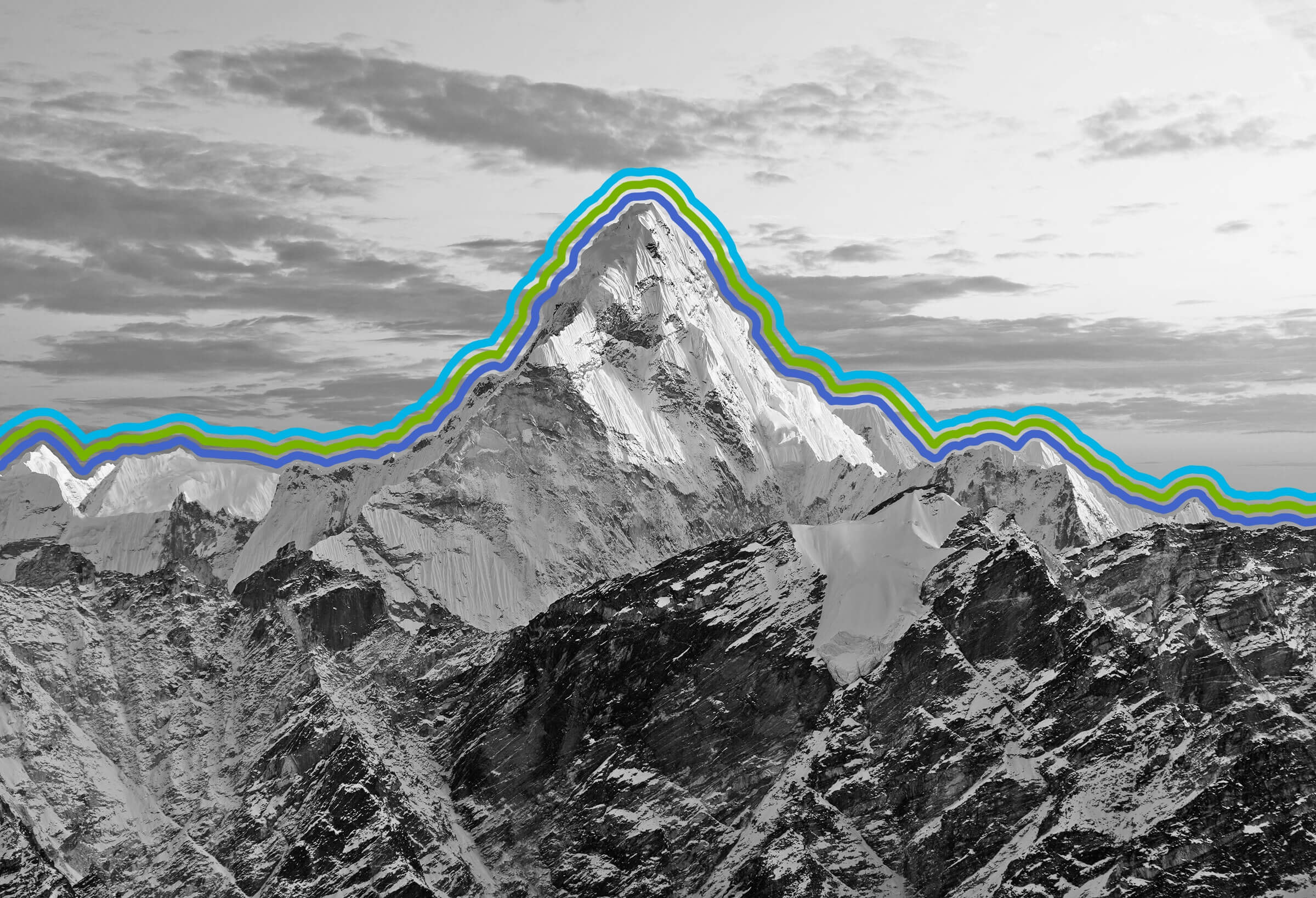

For mountaineers looking to climb the world’s most challenging peaks, Everest is the top prize. At 29,032 feet, Everest is the highest mountain in the world in terms of elevation and the crown jewel of the Himalayas. (Overall, the region is home to nine of the 10 highest peaks in the world, with the exception being K2 in the Karakoram range.) Although its height is its most touted feature, Mount Everest is the subject of many incredible facts — some of which stretch 50 million years into the past.
Mount Everest Has Many Names

Beginning in 1802, the Great Trigonometrical Survey was a massive undertaking to painstakingly survey the entire Indian subcontinent (then a colony of Britain). British surveyor George Everest served as the Surveyor General of India for 13 years (1830 to 1843) before retiring and returning to Britain.
In 1865, a mountain previously named “Gamma,” “peak b,” and finally “Peak VX” received a new name that finally stuck — Mount Everest. Everest’s name was put forward in 1856 by his successor, Andrew Scott Waugh, in honor of his friend and mentor. However, the traditional Tibetan name of the mountain is Chomolungma, which means “Goddess Mother of the World.” The Sanskrit name is Sagarmatha, or “Peak of Heaven.”
Everest Never Saw the Peak Named After Him

Although George Everest dedicated his life to surveying the Indian subcontinent, he never traveled to Nepal, and likely never saw the famous peak that now bears his name. His closest connection with the mountain was through his protégé Andrew Scott Waugh, who made the first scientific observations of the mountain and announced its height at 8,840 meters (29,002 feet) in 1856. This height surpassed Kangchenjunga, a nearby mountain then considered the world’s highest peak. Although K2 came close to knocking it out of the top spot, no other mountain has ever surpassed Everest’s impressive stature.
Everest Started Forming 50 Million Years Ago

About 50 million years ago, only 5 or 6 million years after the cataclysmic end of the dinosaurs, the Indian subcontinent — traveling some 15 centimeters per year — closed an ancient sea named Tethys and collided with the Eurasian continent. As the two tectonic plates buckled, they formed a dramatic uplift that created Everest along with the rest of the Himalayan mountain chain. Additionally, Everest’s location near the Tropic of Cancer means that mountain glaciers (ice masses that carve away most mountains) are relatively small on Everest, which is part of why it remains so impressively massive to this day.
Everest Grows 4 Millimeters Per Year

Everest is already the highest peak above sea level, and it’s still growing. The ancient collision that formed the mountain many millions of years ago is still ongoing, as India continues to advance northward about 2 inches per year. In fact, in 10 million years, India will plow into Tibet by more than 100 miles, effectively erasing the country of Nepal. Through all this tectonic drama, Everest will continue climbing an additional 4 millimeters, or roughly 0.16 inches, per year.
Mount Everest Is the World’s Highest Mountain — But Not the Tallest

Everything’s relative when it comes to measuring the tallest mountain in the world. Going off of a mountain’s number of feet above sea level is what gives Everest the crown, but there are other contenders for the globe’s tallest peak. The most obvious one is Mauna Kea, a shield volcano in Hawaii that is the tallest mountain in the world when measured from base to peak. In total, Mauna Kea is about 33,000 feet — roughly 4,000 feet taller than Everest.
Another contender is Mount Chimborazo. At 20,564 feet above sea level, this mountain in Ecuador doesn’t even come close to Everest’s height. However, when measuring from the center of the Earth, Mount Chimborazo gets a big boost by being located near the equator. Because the planet bulges at its middle due to the centrifugal forces produced by its rotation, Mount Chimborazo is actually around 6,800 feet taller than Everest.
Jumping Spiders Are the Only Permanent Residents on Everest

The high altitude of Everest makes it difficult for life to thrive on its slopes — difficult but not impossible. The Himalayan jumping spider is the only known permanent resident on Mount Everest, making it one of the highest-living species on Earth. This impressive feat is even honored in its scientific name, Euophrys omnisuperstes, which means “standing above everything.” Because the spider needs to feed on other insects, it likely feasts on flies and other bugs blown up from lower altitudes, as part of what’s known as an Aeolian Biome.
Sherpas Have Evolved To Be Everest-Summiting Pros

The Sherpa people are a tribe native to Nepal, Tibet, and the Himalayan region, and are often guides for foreign adventurers looking to reach the top of Everest and other Himalayan peaks. Scientists have studied the biology of these Native people and discovered that Sherpas have evolved over thousands of years to be excellent climbers in high altitudes.
Climbing Everest’s peak involves a variety of challenges, but one of the deadliest is hypoxia and altitude sicknesses known as HAPE (high altitude pulmonary edema) or HACE (high altitude cerebral edema) — all results of the body’s inability to function properly in low-oxygen environments. With the first known Sherpas living in the region some 30,000 years ago, this tribal group’s mitochondria are much more efficient at using oxygen when it’s scarce compared to “lowlanders.” This amazing ability is why Sherpas hold many mountaineering records, including the most ascents of Everest by a single person (26).
